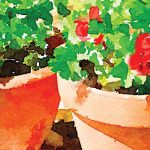
How U.S. Kids Golf conquered the world
By Lee Pace
Dan Van Horn was coaching his sons’ youth league baseball teams in the mid-1990s when he noticed the quality and variety of baseball bats being manufactured to address the youth market. Versions in aluminum and carbon fiber polymers with narrow barrels, lighter weights and nuanced weight distribution helped kids take a healthy cut and develop their form without being burdened with weights their small limbs and core couldn’t handle.
It occurred to Van Horn, a lifelong golfer, former mini-tour player and a father with an interest in his children learning the game, that the golf industry did a poor job addressing adolescent golfers in a similar fashion.
“You could find junior sets with a 3-wood, 5-, 7- and 9-irons that were essentially adult clubs, sawed off and a ‘junior’ label slapped on,” the Atlanta businessman says of his 1995 “ah-ha” moment. “The clubs were too heavy, the kids didn’t hit many good shots, and they didn’t have any fun. I sensed there was an opportunity there.”
The first domino fell one year later when he incorporated U.S. Kids Golf with the idea of manufacturing “ultra-light” clubs for kids based on their body heights with shaft flexes and swing weights geared to each length. The next domino fell in 1997 when the first club rolled off the assembly line.
“It was all about having fun,” Van Horn says. “If you play well, you’ll have fun. If you’re having fun, you might buy in for a lifetime.”
The dominoes kept falling through the years — establishing competitions for kids on local, regional, national and worldwide stages; setting junior-oriented tee markers so a 9-year-old could hit a driver and 6-iron on a par-4 like his dad does; coming to Pinehurst in 2006 for world championships that have become staples in the local golf scene; and creating coaching programs to help PGA of America members learn how to better teach and connect with kids and sell their memberships on the value of drawing children into golf.
In 2015 one of the most interesting dominoes yet fell: the purchase of a struggling club in the Sandhills, and the establishment of a working “golf laboratory” with a mission of teaching and growing the game among juniors and families. U.S. Kids Golf Foundation, established in 2000 as a supplement to the U.S. Kids equipment business, bought Longleaf Golf & Country Club in April 2015 and renamed it Longleaf Golf & Family Club.
“We’d been coming here for ten years and kept seeing Longleaf slide a little bit,” Van Horn says. “We wanted to have a presence in the community. We felt very welcome here, very supported by the community. The synergies around the Pinehurst/Southern Pines area as a golf capital, a golf mecca, have been important to us. It seemed like a great place to layer in more of the idea of kids golf, family golf.”
Van Horn and his Atlanta-based company knew what it was like to be a vendor to the golf industry. They understood managing and running tournaments. But there was one key perspective they lacked in the daunting task of expanding a game that is difficult to learn, time-consuming to play, requires considerable financial investment and is fraught with timeless traditions and oftentime stodgy attitudes.
“We wanted to experience the ‘other side of the track,’” Van Horn says. “We wanted to see the challenges in the golf shop on a real-time basis, understand the hindrances in running kids’ golf. We wanted a working laboratory where we could practice our vision of growing the game among kids and families while not disrupting traditional men’s play and club play.”
Van Horn smiles and acknowledges there is a certain dog-catches-the-car-now-what element to the foundation’s fourteen months running Longleaf, a Dan Maples-designed course that opened in the late-1980s golf boom but has struggled amid the early 2000s recession and 2008 financial collapse. Eighty of the course’s sprinklers quit working last summer, and the new owners invested in a new computerized switching and monitoring system to better manage the flow of water around the course. But the sprinklers still didn’t work properly.
“We eventually figured out the original lines ran under Midland Road, and over time the road sank and collapsed the pipes,” Van Horn says. “We wanted to learn the golf operations business. And we’re getting a full education.”
The club facility at Longleaf is teeming this July morning with kids, parents, volunteers and U.S. Kids staff descending here and at Pinehurst Resort & Country Club three miles away for the Red White & Blue Invitational, one of a series of regional competitions leading to the U.S. Kids World Championships spread across ten Sandhills area clubs in early August. This year’s competition is expected to bring nearly 1,600 golfers from more than fifty nations.
The Sandhills wasn’t quite sure what to expect in 2005 when the first U.S. Kids event was held and thousands of visitors from three dozen counties staged a parade through the middle of Pinehurst. All of a sudden, 8-year-olds were playing hide-and-seek in the halls of the venerable Carolina Hotel. Kids hit shots from sand traps by day, sneaked back in to build sand castles by twilight. Kitchen staffs learned to make pigs-in-a-blanket and were ready for French toast orders en masse in the breakfast buffet lines. The 2012 championship was the subject of a 100-minute documentary, The Short Game, that still runs on Netflix and profiles eight youngsters from around the world and their quest to win a world championship.
“I have never seen anything like these kids,” says lifelong Pinehurst resident Marty McKenzie. “These are the highest quality youth on the planet participating in the greatest sport on the planet, and it all takes place in our beloved Pinehurst.”
One initiative from Van Horn and his company that affects not only kids but women, seniors and men whose egos will allow them to stray from the traditional blue-white-red tee system is the implementation of a seven-tee configuration that puts golfers at the correct length of course based on their average driving distance. The practice ground at Longleaf is arrayed with a series of brightly colored stakes numbered one through seven, the closest stake colored blue and located 100 yards away, the middle stake orange at 175 yards and the farthest colored red and set 250 yards off.
A golfer’s average carry dictates which of the seven sets of tees he uses when he gets to the first tee of the course, with the tees at Longleaf ranging from 3,200 to 6,600 yards. The system is clearly explained in colorful signage on the practice tee and first tee. U.S. Kids is working with the American Golf Course Architects Society to educate the industry on setting up courses in this fashion, and the Longleaf staff has entertained emissaries from clubs such as Medinah in Chicago who are interested in making their clubs more welcoming to juniors and newcomers.
“You hear jokes in the industry about three million golfers a year in, three million out,” Van Horn says. “No one has done anything to help people get over what it’s like to be a newcomer in golf. That’s what Longleaf is all about.
“Now we have women playing a course 3,200 yards. It’s faster and more fun. They’re making pars and some birdies. Now they can actually reach a par-4 in regulation. Before they didn’t stand a chance.”
When Pinehurst hosted the 2014 U.S. Open and Women’s Open, Van Horn and his staff counted 26 competitors in the two fields combined who were U.S. Kids alumni, among them Justin Thomas, Patrick Reed, Lexi Thompson, Beau Hossler, Smylie Kaufman and Mariah Stackhouse.
Van Horn is asked if he could ever have envisioned the empire he’s created over two decades when he wanted better junior clubs for his kids.
“I have a lot of dreams, but I try to be faithful to the vision,” he says. “I take dreams one day at a time and try to be the best every day with it. You always can hope and have grandiose plans. I’m honestly frustrated that it’s not bigger than it is. I didn’t get into this for financial gain. I am doing it because I felt called spiritually and I feel like it’s my life’s mission. Maybe my entire life, I didn’t know what I was supposed to be doing. Now I do and here I am.” PS
Chapel Hill-based writer Lee Pace is the author of a dozen books on golf history, including The Golden Age of Pinehurst—The Story of the Rebirth of No. 2.





